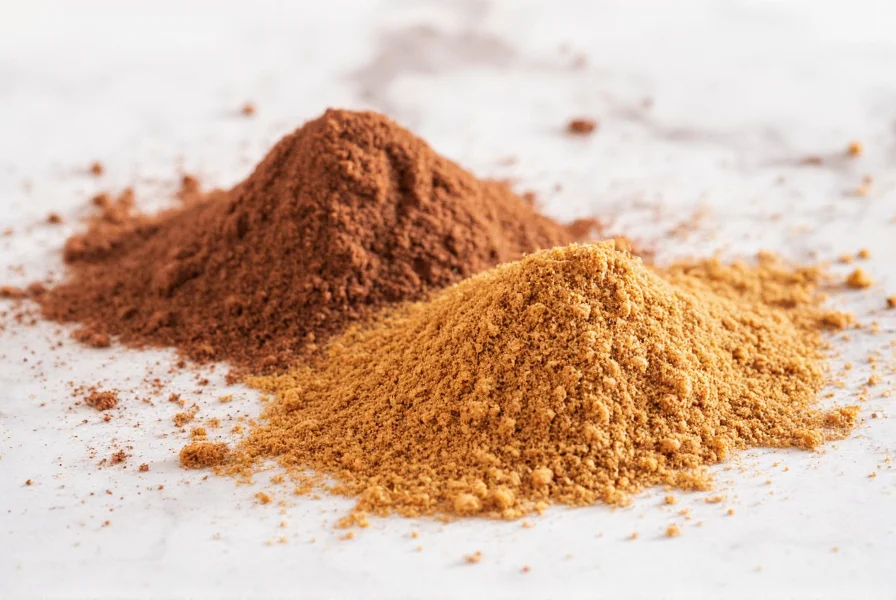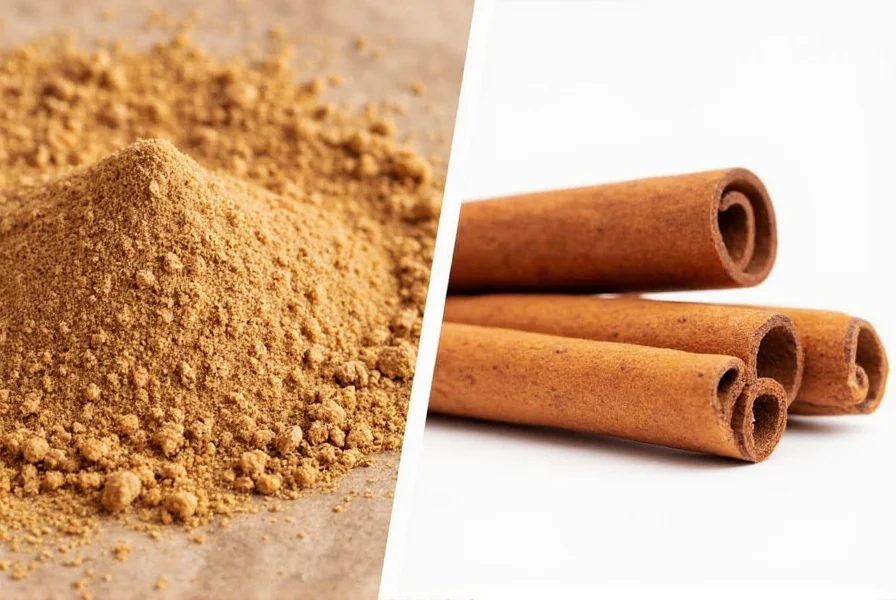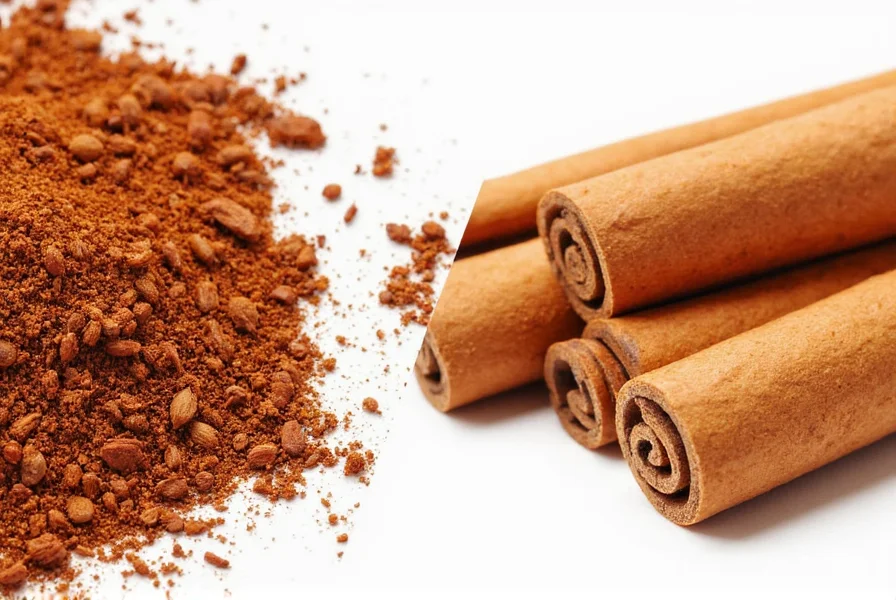Table of Contents
- Key Differences at a Glance
- What Is True Cinnamon (Ceylon)?
- What Is Cassia Spice?
- Comprehensive Comparison Table
- Culinary Applications: When to Use Each
- Health Implications and Safety Guidelines
- How to Identify True Cinnamon vs Cassia
- Buying Guide: Selecting the Right Spice
- Frequently Asked Questions
Key Differences at a Glance
When searching for "cassia vs cinnamon," users want immediate clarity. The critical differences: true cinnamon (Ceylon) comes from Cinnamomum verum trees in Sri Lanka, has very low coumarin (under 0.01%), and offers a delicate, sweet flavor. Cassia (often labeled as cinnamon in North America) comes from Cinnamomum cassia, contains up to 1% coumarin, and has a stronger, spicier taste. Most "cinnamon" sold in US supermarkets is actually cassia.

What Is True Cinnamon (Ceylon)?
Ceylon cinnamon, often called "true cinnamon," is harvested from the inner bark of Cinnamomum verum trees primarily grown in Sri Lanka. This variety represents only about 10-15% of the global cinnamon market but is prized for its superior quality and safety profile.
Unlike cassia, Ceylon cinnamon forms multiple thin layers that resemble a cigar roll. When broken, it produces a fine powder rather than coarse fragments. Its flavor profile is complex with citrus and floral notes, making it ideal for delicate dishes where subtle spice is preferred.
- Scientific name: Cinnamomum verum
- Primary origin: Sri Lanka (formerly Ceylon)
- Average coumarin content: 0.004-0.016%
- Flavor characteristics: Sweet, citrusy, floral, with subtle warmth
- Visual identification: Multiple thin, brittle layers forming soft quills
What Is Cassia Spice?
Cassia, frequently sold as "cinnamon" in North America, comes from Cinnamomum cassia trees grown predominantly in China, Vietnam, and Indonesia. It accounts for approximately 85-90% of cinnamon sold in the United States.

Cassia has a more intense flavor profile with pronounced spiciness and slight bitterness. Its bark is thicker, harder, and forms a single, dense quill. The higher coumarin content (up to 1% by weight) makes it less suitable for regular, high-volume consumption, particularly for individuals with liver conditions.
- Scientific name: Cinnamomum cassia
- Primary origins: China, Vietnam, Indonesia
- Average coumarin content: 0.4-1.0%
- Flavor characteristics: Strong, spicy, slightly bitter, with warm notes
- Visual identification: Thick, solid single-layer quills that are difficult to break
Comprehensive Comparison Table
| Characteristic | Ceylon Cinnamon | Cassia |
|---|---|---|
| Botanical Name | Cinnamomum verum | Cinnamomum cassia |
| Origin | Sri Lanka | China, Vietnam, Indonesia |
| Physical Structure | Multiple thin layers forming soft quills | Single thick, hard layer |
| Color | Light tan to pale brown | Dark reddish-brown |
| Taste Profile | Sweet, floral, citrus notes, subtle warmth | Strong, spicy, slightly bitter, intense warmth |
| Coumarin Content | Very low (0.004-0.016%) | High (0.4-1.0%) |
| Market Share in US | 10-15% | 85-90% |
| Average Price (per ounce) | $3.50-$5.00 | $1.50-$2.50 |
| Recommended Daily Limit | No established limit | 1 teaspoon (approx. 2.5g) for adults |
Culinary Applications: When to Use Each
Understanding when to reach for Ceylon versus cassia can significantly impact your cooking results. The choice affects both flavor balance and safety for regular consumption.
Ideal for Ceylon Cinnamon
Choose true cinnamon when you want a subtle, aromatic spice that won't overpower delicate flavors:
- European-style pastries and cakes
- Custards, flans, and rice puddings
- Fruit-based desserts (apple pie, peach cobbler)
- Lighter spice blends like pumpkin pie spice
- Beverages like hot chocolate and mulled wine

Ideal for Cassia
Opt for cassia when you need a robust spice that can stand up to strong flavors:
- Traditional Chinese five-spice powder
- Mexican mole sauces
- Indian curries and biryanis
- Spiced chai and masala teas
- Hearty meat rubs and marinades
Substitution Guidelines
When substituting between varieties, follow these precise measurements:
- Cassia for Ceylon: Use 50-75% of the amount called for (e.g., ¾ tsp cassia for 1 tsp Ceylon)
- Ceylon for Cassia: Use 125-150% of the amount called for (e.g., 1¼ tsp Ceylon for 1 tsp cassia)
- For daily consumption: If using cassia regularly, limit to 1 tsp (2.5g) per day
- For children: Ceylon is strongly recommended; limit cassia to occasional use
Health Implications and Safety Guidelines
Both spices offer health benefits, but the coumarin difference creates important safety considerations many consumers overlook.
Health Benefits Comparison
Both varieties contain cinnamaldehyde, responsible for many health benefits:
- Antioxidant properties (27 different protective compounds identified)
- Blood sugar regulation (studies show 10-29% improvement in insulin sensitivity)
- Anti-inflammatory effects (reduces markers like TNF-α and IL-6)
- Potential heart health benefits (may lower triglycerides and LDL cholesterol)
Coumarin Content: Critical Safety Information
Coumarin, naturally higher in cassia, requires careful consideration:
- Daily limits: European Food Safety Authority recommends 0.1mg coumarin per kg body weight
- For a 150lb (68kg) adult: Maximum 6.8mg coumarin daily
- Cassia content: 1 teaspoon (2.5g) contains 5-12mg coumarin - potentially exceeding safe limits
- Ceylon content: 1 teaspoon contains 0.006-0.024mg coumarin - well below safety thresholds
- Vulnerable groups: Children, pregnant women, and those with liver conditions should use Ceylon exclusively
Who Should Choose Ceylon Cinnamon?
- Regular users (daily consumption)
- Individuals with liver conditions
- Children and pregnant women
- Those taking blood thinners (coumarin has blood-thinning effects)
- People using cinnamon supplements
How to Identify True Cinnamon vs Cassia
Learning to distinguish between these spices prevents accidental overconsumption of coumarin. Here's how to tell them apart:
Physical Identification
- Ceylon: Multiple thin, papery layers that crumble easily when bent
- Cassia: Thick, hard single layer that resists bending and doesn't break easily
- Ground spice: Ceylon is lighter tan; cassia is dark reddish-brown
Flavor Test
- Ceylon: Sweet aroma with citrus notes; milder taste that builds gradually
- Cassia: Intense, almost medicinal aroma; immediate sharpness with slight bitterness
Purchase Verification
- Look for "Ceylon" or "True Cinnamon" on the label
- Check for Sri Lankan origin (not just "imported")
- Avoid products labeled simply as "cinnamon" in the US (likely cassia)
- Premium spice brands often specify the variety used
Buying Guide: Selecting the Right Spice
Choosing quality spices ensures both flavor and safety. Here's what to look for when purchasing:
For Home Cooks on a Budget
- Use cassia for occasional cooking in robust dishes
- Limit cassia to no more than 1 tsp (2.5g) per day
- Choose Vietnamese cassia (Saigon cinnamon) for better flavor than Chinese varieties
- Buy whole sticks rather than powder for longer shelf life
For Regular Cinnamon Users
- Invest in Ceylon cinnamon for daily consumption
- Look for Sri Lankan certification on packaging
- Reputable brands include Simply Organic, Frontier Co-op, and King Arthur Flour
- Store in airtight containers away from light and heat
Storage and Shelf Life
- Whole sticks: 3-4 years when stored properly
- Ground spice: 1-2 years (loses potency faster)
- Best storage: Dark glass containers in a cool, dry cupboard
- Signs of deterioration: Faded color, weak aroma, musty smell
Frequently Asked Questions
Is cassia the same as cinnamon?
No, they're distinct spices. True cinnamon (Ceylon) comes from Cinnamomum verum trees in Sri Lanka, while cassia (often labeled as cinnamon in North America) is from Cinnamomum cassia trees grown in China and Indonesia. Cassia has a stronger, spicier flavor and contains significantly more coumarin than true cinnamon. Most supermarket "cinnamon" in the US is actually cassia.
Which is healthier: cinnamon or cassia?
Ceylon cinnamon is generally healthier for regular consumption because it contains very low levels of coumarin (less than 0.01%), while cassia contains high levels (up to 1%). Coumarin can cause liver damage when consumed in excess. Both offer similar antioxidant benefits, but Ceylon is safer for daily use, especially for children, pregnant women, and those with liver conditions.
How can I tell the difference between cinnamon and cassia?
Examine the sticks: Ceylon cinnamon forms thin, multiple-layered rolls that are light brown and crumble easily, while cassia forms thick, hard single-layer quills that are dark reddish-brown and resist breaking. Taste-wise, Ceylon is sweet and floral while cassia is stronger and slightly bitter. The most reliable method is checking your spice label for "Ceylon" or "true cinnamon"—products labeled simply as "cinnamon" in North America are typically cassia.
What's the safe daily limit for cassia cinnamon?
Based on European Food Safety Authority guidelines, the safe daily limit for coumarin is 0.1mg per kg of body weight. For a 150-pound (68kg) adult, this equals approximately 6.8mg of coumarin. Since cassia contains 0.4-1.0% coumarin, one teaspoon (2.5g) of cassia typically contains 5-12mg of coumarin—potentially exceeding the safe daily limit. Therefore, limit cassia consumption to no more than 1 teaspoon (2.5g) per day for adults, and use Ceylon cinnamon for regular or higher consumption.
Why does the US market mostly sell cassia as cinnamon?
Cassia dominates the US market primarily because it's cheaper and easier to produce. Ceylon cinnamon requires labor-intensive harvesting of thin inner bark layers, while cassia comes from thicker bark that's simpler to process. Historically, American consumers associated the stronger cassia flavor with "cinnamon," so manufacturers continued labeling it as such. The USDA allows both to be labeled as "cinnamon," unlike the EU which requires clear differentiation. This practice continues due to consumer familiarity with the stronger flavor profile.










 浙公网安备
33010002000092号
浙公网安备
33010002000092号 浙B2-20120091-4
浙B2-20120091-4